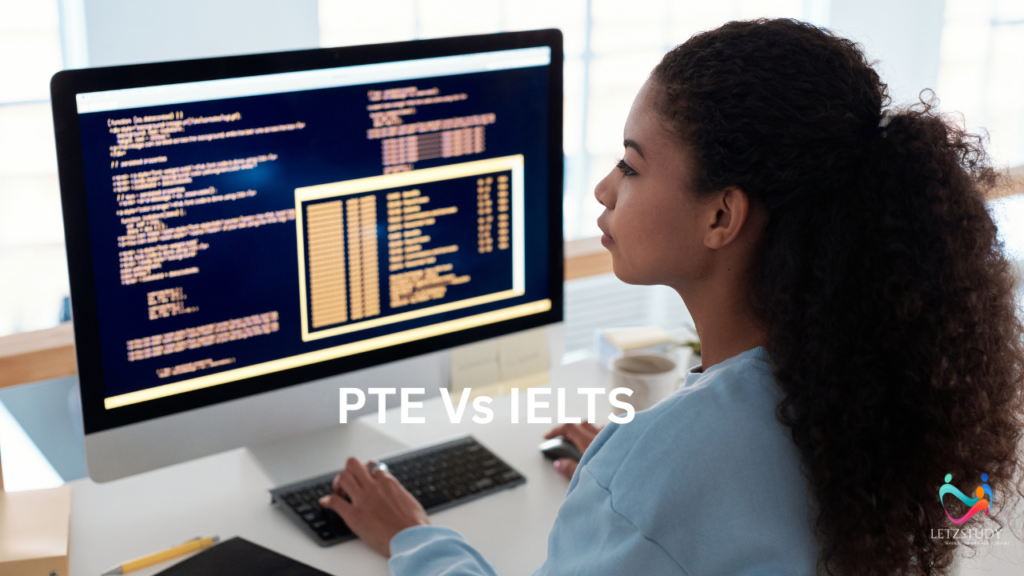
Introduction
Choosing between IELTS and PTE can be challenging. Both tests assess English proficiency, but they differ in format, scoring system, and acceptance. Whether for higher education or immigration, selecting the right test is crucial.
This guide will help you understand the pros and cons of each test and determine which one best suits your needs. Read on to make an informed decision!
PTE vs IELTS: The Key Differences
Both tests assess writing, reading, speaking, and listening skills. However, they differ in the following areas:
- Testing Formats: PTE is fully computer-based, while IELTS offers paper-based and computer-based versions.
- Scoring System: PTE employs AI-based scoring for consistency, whereas IELTS uses human examiners.
- Test Duration: PTE takes 2 hours, while IELTS lasts 2 hours and 45 minutes.
- Speaking Section: PTE records responses via a computer, while IELTS involves a face-to-face interview.
- Results Time: PTE results arrive within 48 hours. IELTS results take 3-5 days (computer-based) and 13 days (paper-based).
Testing Format Comparison
1. Listening
- PTE: 30-40 minutes, mixed question types with various audio clips.
- IELTS: 30 minutes, four sections with different audio formats.
2. Reading
- PTE: 29-30 minutes, includes fill-in-the-blanks and paragraph reordering.
- IELTS: 60 minutes, includes multiple-choice questions, matching headings, and paragraph completion.
3. Writing
- PTE: 20 minutes, involves summarizing a text and writing an essay.
- IELTS: 60 minutes, includes graph descriptions and essay writing.
4. Speaking
- PTE: AI-based recorded responses via a microphone.
- IELTS: Face-to-face interview with a human examiner.
PTE vs IELTS: Which is More Convenient?
- PTE is better for those who are tech-savvy and comfortable with computer-based tests.
- IELTS is ideal for candidates who prefer human interaction, especially in the speaking section.
- AI-based scoring in PTE eliminates bias, while IELTS scoring depends on human interpretation.
Recognition and Acceptance
Both exams are widely accepted, but preferences vary by institution:
- PTE: Recognized in Australia, New Zealand, the UK, and some U.S. institutions.
- IELTS: Accepted globally, especially in Europe, the UK, Australia, and other regions.
The Pros and Cons of Each Exam
Pros of PTE
Faster results (within 48 hours) ✔ AI-based scoring (no human bias) ✔ Fully computer-based
Cons of PTE
Less widely accepted than IELTS ✖ Can be challenging for non-tech-savvy candidates
Pros of IELTS
Internationally recognized ✔ Offers both paper-based and computer-based formats ✔ Face-to-face speaking test for more interaction
Cons of IELTS
Results take longer (up to 13 days for paper-based tests) ✖ Human grading may lead to subjective bias

IELTS vs PTE: Which Test Should You Take?
| Criteria | PTE | IELTS |
| Test Format | Fully computer-based | Paper & Computer-Based |
| Scoring | AI-Based | Human Examiners |
| Speaking | Recorded Responses | Face-to-Face Interview |
| Results Time | 48 Hours | 3-13 Days |
| Global Recognition | High | Very High |
Who Should Take PTE?
- Candidates comfortable with AI-based testing.
- Those who need faster results.
- People who prefer objective scoring.
Who Should Take IELTS?
- Candidates who prefer human interaction in the speaking test.
- Students applying for UK and European universities.
- Test-takers who feel comfortable with traditional exams.
IELTS vs. PTE: 6 Common Challenges Students Face and How to Overcome Them
1. Choosing the Right Test
Issue: Many students struggle to decide which test suits their needs.
Solution: Research institution requirements and test formats.
2. Speaking Section Challenges
Issue: IELTS requires face-to-face interaction, while PTE is AI-based.
Solution: Choose IELTS if you prefer human interaction; opt for PTE if you’re comfortable speaking into a microphone.
3. Writing Difficulties
Issue: Many students find essay writing difficult.
Solution:
- IELTS: Improve handwriting (for paper-based tests) and essay structuring.
- PTE: Learn how the AI scoring system works and focus on grammar & clarity.
4. Time Management Issues
Issue: Strict time limits make it difficult to complete tasks.
Solution: Take mock tests under timed conditions and practice time management strategies.
5. Understanding the Scoring System
Issue: Misinterpreting scores leads to confusion.
Solution:
- IELTS uses band scores (1-9).
- PTE scores numerically (10-90).
- Use official conversion charts to compare scores.
6. Test Center Availability
Issue: Difficulty in finding test slots.
Solution:
- IELTS: More test centers worldwide.
- PTE: Fully computerized, offering faster results.
13 Expert Tips to Choose Between PTE and IELTS in 2025
- Understand the Basic Differences: PTE is fully computerized, while IELTS has paper and computer options.
- Check University/Immigration Requirements: Some countries prefer IELTS, while PTE is gaining popularity.
- Consider the Exam Format: Choose the one that matches your strengths.
- Which One is Easier?: PTE suits tech-savvy individuals, IELTS suits traditional test-takers.
- Speaking Section: AI vs. Human Examiner: PTE uses AI; IELTS involves human interaction.
- Writing Section: Typing vs. Handwriting: Choose PTE if you prefer typing, IELTS if you prefer handwriting.
- Scoring System: PTE is AI-graded, while IELTS is human-evaluated.
- Exam Duration: PTE – 2 hours; IELTS – 2 hours 45 minutes.
- Results Time: PTE (48 hours), IELTS (3-13 days).
- Cost Comparison: Costs vary by country but are similar.
- Retake Policy: PTE allows re-attempts within 5 days; IELTS requires rebooking.
- Which One is Best in 2025?: PTE for quick results, IELTS for human-graded tests.
- Final Tip: Take a mock test to see which one suits you best!
PTE vs. IELTS: Which Test is Right for You?
If you’re preparing to study or work abroad, selecting the best English proficiency test is essential. The two most well-known tests are the Pearson Test of English (PTE) and the International English Language Testing System (IELTS). Which one will suit you best? Let’s explore the details to help you make an informed choice.
What’s the Difference Between IELTS and PTE?
PTE and IELTS are both English proficiency tests accepted by immigration authorities and universities worldwide. The main differences lie in their formats and evaluation techniques:
- PTE: Completely computer-based, using AI to score.
- IELTS: Offers both paper-based and computer-based formats, with human examiners for the speaking test.
Key Differences Between PTE and IELTS
| Feature | PTE | IELTS |
| Test Format | Computer-based | Paper & Computer-based |
| Speaking Test | AI-scored with recorded responses | Recorded or face-to-face responses |
| Scoring System | AI-driven, unbiased | Human-evaluated |
| Results Time | Within 48 hours | 3 to 13 days |
| Acceptance | Immigration & universities in Australia, New Zealand, Canada, UK | Worldwide acceptance for work, education, and immigration |
| Difficulty Level | Easier for tech-savvy test-takers | Best for those comfortable with human interaction |
Which Test Should You Take?
Consider these questions:
Are you comfortable with computer-based testing? Choose PTE.
Do you prefer talking to a human examiner? Opt for IELTS.
Do you need quick results? PTE provides scores within 48 hours.
Are you applying to the UK, Australia, or New Zealand? Both tests are accepted.
Real-World Examples and Trends
Many students find PTE easier because of its AI-based scoring, reducing human bias. However, IELTS remains the preferred test in the UK due to its long-standing credibility. Recent trends show PTE’s growing popularity among test-takers who prefer a faster, tech-driven approach.
If you’re tech-savvy and need quick results, go for PTE.
If you prefer human interaction and a traditional test format, IELTS may be better for you.
PTE vs. IELTS: Statistics & Data
For an in-depth comparison, check official reports from:
- Pearson (PTE)
- IDP/British Council (IELTS)

Case Studies: Real Student Experiences
1. Anaya’s PTE Success Story
From: Bangalore, India
Goal: Study in Australia
Challenge: Typing over face-to-face interaction
Solution: Chose PTE with expert guidance
Outcome: Secured admission at University of Melbourne
2. Raj’s IELTS Advantage for the UK
From: India
Goal: MBA in the UK
Challenge: Choosing the most accepted test
Solution: Took IELTS (widely recognized for UK universities)
Outcome: Scored above requirements & got into Oxford University
3. Ravi’s Balanced Approach to PTE
From: Hyderabad, India
Goal: Study in Australia
Challenge: Needed fast visa approval
Solution: Took PTE (faster results)
Outcome: Successfully applied on time
Need help choosing between IELTS & PTE?
Contact LetzStudy for expert guidance!
Phone: 938O486921
Expert Opinions on PTE vs. IELTS
Dr. Adrian Cohen (Linguistics Expert & Test Prep Specialist):
“PTE offers rapid, AI-based scoring, making it ideal for tech-savvy test-takers. IELTS, however, focuses on live communication skills, benefiting those who prefer human interaction.”
Emily Carter (Senior Language Assessment Consultant):
“Choosing between PTE and IELTS depends on your strengths. If you’re comfortable with computer-based tests and time management, PTE is a great option. If you excel in structured composition and face-to-face interactions, IELTS is better.”
For more information, connect with us on LinkedIn and for daily updates, follow us on Instagram

